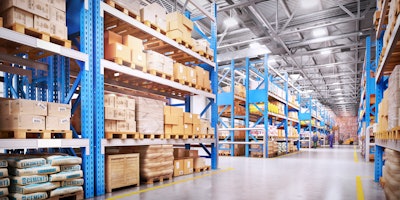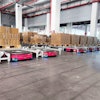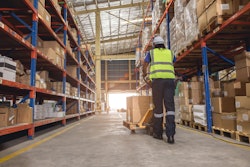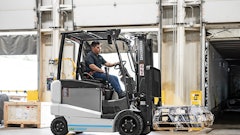
Today’s warehouses face constant pressure to fulfill greater volumes of orders at an increasingly fast pace. Meeting these intense throughput targets depends on lift truck operators performing at their best every day. As operations work to maximize productivity and efficiency, maintaining a strict focus on lift truck best practices and facility-specific traffic rules can be a challenge. In the event errors do happen, businesses risk compromising equipment, facility infrastructure and the safety of personnel, all of which accumulate financial costs and unplanned downtime they simply cannot afford.
With so much riding on the performance of lift truck operators, it’s imperative to build and support safe, effective habits through proper, comprehensive training. And just as technology has optimized other aspects of warehouse operation, it can also elevate lift truck operator training, from virtual reality simulators that can supplement OSHA-mandated instruction to modernized training videos and instructional formats that can support engagement and comprehension in adult learners.
Operator assistance technologies can take these initiatives a step further by offering automated assistance and alerts to operators in real time on the warehouse floor.
What Are Operator Assistance Technologies?
While some may be familiar with systems that consider equipment status or load stability to provide a visual alert or even performance intervention in limited circumstances, a more advanced technology can go several steps further. These advanced solutions also leverage information related to the operating environment, including precise, real-time location and proximity data to enable automatic performance adjustments for a range of scenarios tailored to warehouse operations.
Some of these capabilities include:
- Overload arrest to prevent lifting and carrying loads that exceed weight limits
- Automatic speed reduction when cornering for stability
- Preventing equipment from entering designated pedestrian-only zones
- Line of sight support to help reinforce operator awareness
- Location-based fork height restriction to help avoid low-hanging beams or other obstacles
- End of aisle slowdown when approaching the end of an aisle or intersection
- Limited speed and acceleration when moving in pedestrian-heavy areas
Advanced solutions require a robust technology stack to make those operator-assist functions possible. Certain core technologies can continuously analyze truck performance and operating condition inputs to implement performance adjustments without upsetting stability.
The User Experience
From the perspective of end users, what do alerts and automated performance intervention look like in practice? In many warehouses, employees are accustomed to wearing a lanyard with an access card or ID badge. Wearable electronic tags with proximity sensors look very similar. In the work environment, when pedestrians wearing proximity tags come within a pre-defined distance of a piece of connected equipment, their tag vibrates to help make them aware of the situation. For lift truck operators, the system tracks the distances between their trucks, other connected equipment and tag-wearing pedestrians. If a proximity threshold is breached, the lift truck automatically slows down to provide the operator with clear notice of the issue and with additional reaction time. Operators are also notified of the cause for the adjustment through a display screen, providing an additional layer of feedback to help reinforce lift truck operation best practices established during training.
While advanced systems limit performance based on real-time equipment status, location and operating conditions, the operator always remains in control of the lift truck. With the truck slow-down functionality, for instance, these systems activate automatic speed reduction based on rules specific to certain areas of the facility like ends of aisles or heavy pedestrian zones. The truck speed will proactively slow down to reinforce adherence to location-specific rules, but the operator maintains control of steering and braking to enable the operator to steer away from a hazard or bring the truck to a complete stop.
Training Tools
Lift truck operator training starts with a strong foundational program that fulfills OSHA certification requirements for formal instruction, practical training and operator evaluation. Formal instruction requires classroom training and modern approaches designed to incorporate adult learning techniques can help support better engagement and comprehension. For example, dividing material into shorter sections broken up with hands-on learning periods helps keep learners engaged to improve comprehension. Likewise, modernized videos with engaging graphics present information in a visual, easy-to-understand format and pace.
While not a replacement for hands-on instruction, virtual reality simulators can allow operators to get additional training exposure in an immersive environment without using actual equipment, preventing interference with regular operations and potential risk of injury or damage to the equipment, product or facility. Virtual reality simulations can even be customized to mimic the particular environment in which trainees will work, complete with racking layouts, aisle widths and more.
A Solution for a Challenging Labor Market
According to industry research, best-in-class warehouse operations experience less than 5% annual workforce turnover. But for most, that’s far from reality, as industry-wide turnover has averaged over 40% in recent years, and some businesses experience even higher rates.
With such high turnover, businesses are challenged to cope with the revolving door and must prioritize training and constantly reinforce operating best practices. Investing in operator assistance technologies can help warehouses prioritize worker safety initiatives while also meeting the demands of the modern warehouse.

![Pros To Know 2026 [color]](https://img.sdcexec.com/mindful/acbm/workspaces/default/uploads/2025/08/prostoknow-2026-color.mduFvhpgMk.png?auto=format%2Ccompress&bg=fff&fill-color=fff&fit=fill&h=100&q=70&w=100)







![Pros To Know 2026 [color]](https://img.sdcexec.com/mindful/acbm/workspaces/default/uploads/2025/08/prostoknow-2026-color.mduFvhpgMk.png?ar=16%3A9&auto=format%2Ccompress&bg=fff&fill-color=fff&fit=fill&h=135&q=70&w=240)





